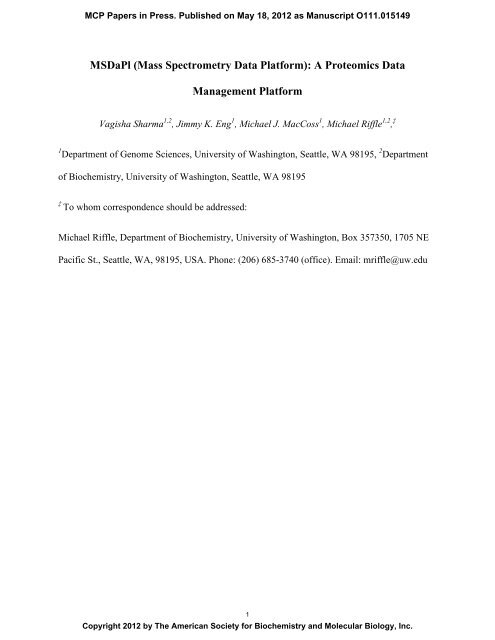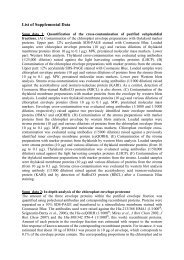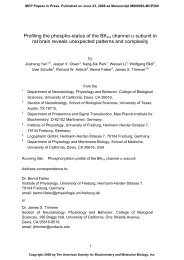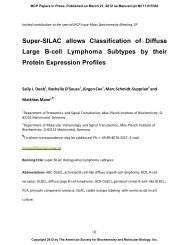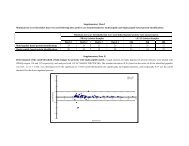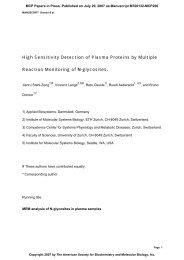MSDaPl - Molecular & Cellular Proteomics
MSDaPl - Molecular & Cellular Proteomics
MSDaPl - Molecular & Cellular Proteomics
Create successful ePaper yourself
Turn your PDF publications into a flip-book with our unique Google optimized e-Paper software.
MCP Papers in Press. Published on May 18, 2012 as Manuscript O111.015149<br />
<strong>MSDaPl</strong> (Mass Spectrometry Data Platform): A <strong>Proteomics</strong> Data<br />
Management Platform<br />
Vagisha Sharma 1,2 , Jimmy K. Eng 1 , Michael J. MacCoss 1 , Michael Riffle 1,2 , ‡<br />
1 Department of Genome Sciences, University of Washington, Seattle, WA 98195, 2 Department<br />
of Biochemistry, University of Washington, Seattle, WA 98195<br />
‡ To whom correspondence should be addressed:<br />
Michael Riffle, Department of Biochemistry, University of Washington, Box 357350, 1705 NE<br />
Pacific St., Seattle, WA, 98195, USA. Phone: (206) 685-3740 (office). Email: mriffle@uw.edu<br />
1<br />
Copyright 2012 by The American Society for Biochemistry and <strong>Molecular</strong> Biology, Inc.
RUNNING TITLE: <strong>MSDaPl</strong>: Mass Spectrometry Data Platform<br />
ABBREVIATIONS:<br />
MS/MS, Tandem Mass Spectrometry<br />
XML, Extensible Markup Language<br />
SQL, Structured Query Language<br />
NCBI, National Center for Biotechnology Information<br />
RDBMS, Relational Database Management System<br />
JSP, Java Server Pages<br />
HTML, Hypertext Markup Language<br />
CSS, Cascading Style Sheets<br />
PSM, Peptide Spectrum Match<br />
PEP, Posterior Error Probability<br />
FDR, False Discovery Rate<br />
2
SUMMARY<br />
Mass spectrometry-based proteomics is increasingly being used in biomedical research.<br />
These experiments typically generate a large volume of highly complex data, and the volume and<br />
complexity are only increasing with time. There exist many software pipelines for analyzing<br />
these data (each typically with its own file formats), and as technology improves, these file<br />
formats change and new formats are developed. Files produced from these myriad software<br />
programs may accumulate on hard disks or tape drives over time, with older files being rendered<br />
progressively more obsolete and unusable with each successive technical advancement and data<br />
format change. Although initiatives exist to standardize the file formats used in proteomics, they<br />
do not address the core failings of a file-based data management system: (1) files are typically<br />
poorly annotated experimentally, (2) files are “organically” distributed across laboratory file<br />
systems in an ad hoc manner, (3) files formats become obsolete, and (4) searching the data and<br />
comparing and contrasting results across separate experiments is very inefficient (if possible at<br />
all). Here we present a relational database architecture and accompanying web application<br />
dubbed <strong>MSDaPl</strong> (Mass Spectrometry Data Platform) that is designed to address the failings of<br />
the file-based mass spectrometry data management approach. The database is designed such that<br />
the output of disparate software pipelines may be imported into a core set of unified tables, with<br />
these core tables being extended to support data generated by specific pipelines. Because the data<br />
are unified, they may be queried, viewed, and compared across multiple experiments using a<br />
common web interface. <strong>MSDaPl</strong> is open source and freely available at<br />
http://code.google.com/p/msdapl/.<br />
3
KEYWORDS: mass spectrometry, proteomics, database, data management, knowledge<br />
management, bioinformatics, data visualization<br />
4
INTRODUCTION<br />
Mass spectrometry-based proteomics is a rapidly developing technology that is<br />
increasingly being applied to biological and biomedical research. Many software applications<br />
have been developed to analyze mass spectrometry data and each of these programs typically use<br />
(as input) and produce (as output) files of various formats. Not only are these formats often<br />
specific to certain analysis software, but it is often specific to certain versions of that software as<br />
well. And as technology advances, these file formats often change or entirely new formats are<br />
introduced. Data viewers, converters, and analysis software are developed or updated to support<br />
these new formats, rendering older files progressively more obsolete and unlikely to be<br />
supported as input to current programs.<br />
In an effort to improve data portability and address this issue of many disparate<br />
proprietary file formats, important work has gone into the development of standardized and open<br />
data formats. Chief among this work are the XML-based data formats mzML(1), mzIdentML(2),<br />
mzData(3) (deprecated), mzXML(4), and pepXML(5); although non-XML formats have also<br />
been proposed (MGF [http://www.matrixscience.com/help/data_file_help.html], MS2 and<br />
SQT(6), and SQLite(7)). Effort has also been put towards developing a universal application<br />
programming interface (API), dubbed mzAPI(8), to allow third-party applications direct access<br />
to proprietary proteomics formats. As a proof of concept, mzAPI has been used to develop both a<br />
desktop environment(9) and web-based environment(10) for accessing and viewing proteomics<br />
data. Although these efforts are well-developed and portable, they are less than ideal as a data<br />
archival and search format; and they suffer from drawbacks intrinsic to any file-based data<br />
solution:<br />
5
• Files are often spread across file systems, hard drives, and tape backups in an ad hoc<br />
manner, making them hard to locate.<br />
• Files may be poorly annotated with regards to experimental conditions, software<br />
parameters, or even the software used to generate the data.<br />
• File formats become obsolete and eventually unsupported by current tools.<br />
• Visualization tools and analysis software must be installed and maintained to view or<br />
interrogate the data files.<br />
Government and journal rules regarding public data dissemination have led to the<br />
development of online proteomics data repositories such as PRIDE(11), Peptide Atlas(12),<br />
Global Proteome Machine (GPM)(13), Human Proteinpedia(14), and the YRC PDR(15)--all of<br />
which provide unified web-based interfaces to underlying proteomics data stored in relational<br />
databases. Although these resources are very important in terms of data distribution, they are not<br />
typically designed to be part of a laboratory’s archival and workflow process. Tranche(16), a<br />
distributed storage and archival network for proteomics data, provides an effective means of<br />
archiving and distributing data, but it distributes only files and requires that the end-user have<br />
access to visualization and analysis tools capable of working with files of that specific format<br />
before they may be of use. LabKey Server(17) and its accompanying proteomics module<br />
(formally known as CPAS) is a comprehensive and robust proteomics pipeline and workflow<br />
management system. It is highly customizable and includes options for configuring and running<br />
multistep proteomics pipelines, and includes options for viewing the output of the respective<br />
analysis programs. Here we present the Mass Spectrometery Data Platform (<strong>MSDaPl</strong>), a<br />
proteomics data management system that, instead of driving proteomics workflows, focuses on<br />
6
long-term archiving, searching, evaluating, and performing simple analysis of the data that result<br />
from the workflows and may be used to compliment systems such as LabKey Server (Figure 1).<br />
At its core <strong>MSDaPl</strong> uses a unified relational database architecture that supports storing<br />
data generated by multiple pipelines, and may be extended to support more. <strong>MSDaPl</strong> includes<br />
import algorithms for major proteomics pipelines, and once in the database, there are no longer<br />
any dependencies on specific file formats. In addition, the data are searchable and may be<br />
compared across separate experiments (even if the experimental data were generated by different<br />
pipelines). Built on the database is a web application designed for searching the data archive,<br />
evaluating the quality of MS/MS runs, and viewing results. To ensure data portability for<br />
subsequent re-analysis by additional proteomics software and inclusion in public repositories,<br />
data may be exported as mzML and mzIdentML XML, regardless of the original input format.<br />
The web application is developed in Java, and as such, is cross-platform. <strong>MSDaPl</strong> is open source<br />
and may be freely downloaded at http://code.google.com/p/msdapl/.<br />
7
DATA ARCHITECTURE<br />
<strong>MSDaPl</strong> is supported by four primary databases (referred to here as “msData,”<br />
“NR_SEQ,” “Job Queue”, and “Projects Database”) and several ancillary databases created to<br />
provide biological context to MS/MS results (Figure 2). The SQL required to generate these<br />
databases for the MySQL RDBMS is available with the <strong>MSDaPl</strong> distribution at<br />
http://code.google.com/p/msdapl/.<br />
MSDATA DATABASE<br />
At the heart of <strong>MSDaPl</strong> is a database schema, dubbed “msData”, designed to be<br />
independent of any specific mass spectrometry pipeline. This is accomplished by conceptually<br />
separating typical mass spectrometry analysis into three fundamental areas: (1) the raw mass<br />
spectra, (2) peptide searches (including post-translational modifications), and (3) protein<br />
inference. Data describing each of these three areas (regardless of the particular analysis<br />
pipeline) will likely have common attributes, as they are describing the same kind of analysis.<br />
These common attributes are abstracted into a core set of tables in each of these three areas, and<br />
these core tables are populated for every MS run, peptide search, or protein inference result set<br />
loaded into the database. Since all data are represented homogeneously in these core tables, these<br />
core attributes may be searched and displayed using a common interface and results compared<br />
and contrasted across experiments and disparate pipelines.<br />
The core tables may be extended in order to encapsulate data specific to particular mass<br />
spectrometry analysis programs (Figure 3). This is done by creating a new table in the schema<br />
specific to an analysis program where each row may be considered a horizontal extension of the<br />
rows from the core table. For example, a row representing a result in the peptide search results<br />
core table may have a corresponding row in the Mascot(18) results table that acts as a logical<br />
extension of this table. This row in the Mascot table would contain data specific to Mascot that<br />
8
describe that search result. Adding support for new pipelines to the database, then, becomes a<br />
matter of extending the core database schema with tables that encapsulate program-specific<br />
information. (Note that, although adding support to the database for new programs is relatively<br />
simple, importing the data will require development of new code that understands the format--a<br />
task simplified somewhat by implementing the import interface defined in <strong>MSDaPl</strong>.) Support for<br />
data generated by the following programs currently exists in the database:<br />
• SEQUEST(19)<br />
• Mascot<br />
• X!Tandem(20)<br />
• Trans Proteomic Pipeline (PeptideProphet and ProteinProphet)(21)<br />
• Tide(22)<br />
• ProLuCID(23)<br />
• Percolator(24)<br />
NR_SEQ DATABASE<br />
<strong>MSDaPl</strong> uses a database dubbed “NR_SEQ” that allows for unambiguously referencing<br />
proteins by internally-assigned identification numbers. NR_SEQ is designed around a non-<br />
redundant protein sequence table, and a protein is defined as a unique protein sequence with a<br />
particular NCBI taxonomy identification number(25). Each protein may have multiple references<br />
(including names, descriptions, external URLs, and other information) from many data sources,<br />
and each reference is linked to both the protein and the respective data source. Of particular<br />
relevance to <strong>MSDaPl</strong>, these data sources may be FASTA sequence files(26), and these<br />
references may serve as a mapping between the accession strings used to identify sequences in<br />
9
FASTA files and internally-assigned protein identification numbers used to identify those<br />
proteins independently of any particular FASTA file.<br />
<strong>Proteomics</strong> data files typically refer to proteins by the accession strings present in the<br />
FASTA file used to perform the analysis. The sequence databases used to generate these files<br />
may change the sequence associated with accession strings or the accession strings associated<br />
with sequences over time. Thus, attempting to identify the same protein across experiments that<br />
used different FASTA files by mapping accession strings from one database to another (or even<br />
accession strings between multiple versions of the same database) is an inherently unreliable<br />
process (assuming the user even used a FASTA file supported by the mapping). To address this<br />
problem, when data are uploaded to <strong>MSDaPl</strong> these accession strings are mapped to protein<br />
identification numbers in the NR_SEQ database by looking up the accession string in the protein<br />
reference table for the respective FASTA file. These protein identifier numbers are then stored as<br />
experimental results in the “msData” database (in addition to the original accession strings),<br />
which ensures that <strong>MSDaPl</strong> unambiguously and reliably refers to the same protein the same way<br />
across all experiments—regardless of which database (or version of that database) was used to<br />
create a FASTA file. Consequently, users may perform protein-level analysis across experiments<br />
without attempting to map accession strings from one database to another. Additionally, current<br />
names, descriptions, and annotations for proteins may be displayed using preferred protein<br />
databases instead of what may be have been used to generate the FASTA file. In order to achieve<br />
this mapping, the FASTA file must be parsed into the database previous to uploading data. This<br />
parsing is described in more detail under “SOFTWARE ARCHITECTURE.”<br />
10
PROJECTS DATABASE<br />
<strong>MSDaPl</strong> uses a projects database that is designed to facilitate collaboration and data<br />
organization by associating uploaded data with experiments, and experiments with projects. This<br />
database includes support for authentication and limiting access to projects (and data associated<br />
with those projects) to specific users. The projects database ensures that data may always be<br />
viewed in the context of a project, providing meaningful experimental context (including contact<br />
information) to the data that may be lost when files are stored on disk.<br />
JOB QUEUE<br />
The “Job Queue” database exists to store data upload requests made by users of the web<br />
application. Because proteomics data files are typically too large to be uploaded directly via a<br />
web interface, requests to upload data are placed in this database and a separate job queue<br />
manager application periodically scans this database for upload requests and processes pending<br />
uploads. This process is described in more detail in the “JOB QUEUE AND DATA<br />
IMPORTERS” section.<br />
ANCILLARY DATABASES<br />
In order to provide views and analysis in a biological context, such as Gene Ontology(27)<br />
enrichment analysis, <strong>MSDaPl</strong> make use of several ancillary databases created by mirroring<br />
external protein annotation databases. These databases may be downloaded from the <strong>MSDaPl</strong><br />
distribution site.<br />
SOFTWARE ARCHITECTURE<br />
The software developed for <strong>MSDaPl</strong> comprises a web application running on top of the<br />
databases described above, a back end job queue and data importers designed for uploading<br />
MS/MS results to the database, and a FASTA parsing program designed to map FASTA headers<br />
11
to protein identifiers in the database. All software, including source code, is available at the<br />
<strong>MSDaPl</strong> download site at http://code.google.com/p/msdapl/.<br />
<strong>MSDaPl</strong> WEB APPLICATION<br />
Technology<br />
The <strong>MSDaPl</strong> web application was developed using Java and JSP using the Struts web<br />
application framework. It is intended to run using Apache Tomcat, an open source servlet<br />
container also written in Java. Because it is Java-based, the <strong>MSDaPl</strong> web application may be<br />
deployed to any server capable of running Java, including Windows, MacOS, Linux, and others.<br />
The web interface has been developed using standard web technologies and is compatible with<br />
all current web browsers.<br />
Organization<br />
Central to the organization of <strong>MSDaPl</strong> is the concept of a project. All users and data are<br />
assigned to projects, and only users assigned to any given project may view data associated with<br />
that project. All access to <strong>MSDaPl</strong> requires authentication and the front page lists the projects for<br />
which the user is listed as a researcher. Project information (including a title, abstract, progress<br />
report, publications, comments, grants, and users associated with the project) may be edited by<br />
any user listed as a researcher of a project by using the “Edit Project” button present on any<br />
project page. Users may also edit their own information, such as their name, contact information,<br />
username, and password, by using the “Account” tab present at the top of all pages.<br />
To upload data, users may use the “Upload Data” button present on any project page.<br />
This link leads to a form where the user provides basic experimental annotation and indicates the<br />
location of the data. Because data files associated with proteomics experiments are typically too<br />
large to be directly uploaded via HTTP, the data from this form are captured to the database and<br />
12
processed by a “job queue manager” program running as a daemon on the server (or on a<br />
different server). This job queue manager is responsible for downloading the data and importing<br />
it into the <strong>MSDaPl</strong> database schema. This software is described below in the “JOB QUEUE<br />
AND DATA IMPORTERS” section.<br />
Once data are imported into the database they may be accessed from the project page.<br />
Each data upload request is organized into distinct experiments, and multiple experiments may<br />
be uploaded to each project. For each experiment, the user may directly view the peptide search<br />
results (as a list of peptides, associated statistics, and links to view the underlying spectrum) or<br />
protein inference results (as a list of identified proteins, associated statistics, underlying peptides,<br />
and their underlying spectra). All spectra may be viewed using the integrated Lorikeet spectrum<br />
viewer (http://code.google.com/p/lorikeet/), which requires the use of no third party software or<br />
plugins. Users may also download all results from a given experiment as a standards-compliant<br />
mzData and mzIdentML XML files suitable for data dissemination and submittal to public<br />
proteomics data repositories.<br />
Select Features<br />
<strong>MSDaPl</strong> offers tools for viewing, validating, and interpreting MS/MS data that take advantage its<br />
relational database model. Select features are described below.<br />
Protein List Filtering and Comparison Across Experiments: <strong>MSDaPl</strong> provides tools for<br />
filtering and viewing protein lists from experiments, including tools for comparing and<br />
contrasting protein lists across multiple experiments (Figure 4a). For a given experiment,<br />
users may filter protein results by the confidence of the identifications, protein physical<br />
properties, GO annotations, names, descriptions, and peptide sequence.<br />
13
When comparing results across experiments, users are presented with summary<br />
statistics describing numbers of proteins found in each experiment (including a Venn<br />
diagram depicting the intersection of proteins among all experiments) and a list of<br />
proteins found in all experiments that includes visual cues indicating in which experiment<br />
each protein was found. Users may filter this protein list using not only the filtering<br />
options described above, but may also filter the list based on presence (or absence) of the<br />
proteins in any of the experiments being compared. Specifically, the user may choose to<br />
only include proteins from specific experiments if it’s (1) present in all other experiments<br />
being compared (AND), (2) present or absent in other experiments (OR), (3) not present<br />
in other experiments being compared (NOT), or (4) only include proteins present in one<br />
of the experiments being compared, but not the other (XOR).<br />
The protein list may also be sorted according to hierarchical clustering of the<br />
normalized spectrum counts, which provides a method for comparing relative protein<br />
abundance across the experiments. The clustering may be viewed as a PDF-formatted<br />
heatmap or as an interactive HTML heatmap where the user may click on rows of the<br />
heatmap to “zoom” to that protein’s row in the main protein list or view a bar graph<br />
depicting that protein’s spectrum counts across the experiments being compared.<br />
Note that the results may be compared across experiments, and indeed, across<br />
totally separate projects where disparate software pipelines and FASTA files were used in<br />
the analysis. There are no restrictions on specific pipelines or naming databases that must<br />
be used in order to perform this analysis.<br />
14
Gene Ontology Analysis: To help apply biological context to protein inference results,<br />
<strong>MSDaPl</strong> provides two types of GO analysis to users. The first type provides a pie graph<br />
and list of the most represented GO terms based on the GO annotations for the proteins<br />
found in a given run. The second type provides a pie graph and list of the most<br />
statistically enriched GO terms based on an enrichment analysis that calculates a p-value<br />
for each GO term based on the hypergeometric distribution given the number of proteins<br />
found in the run, number of proteins in the respective organism annotated with the given<br />
GO term, the number of proteins in the run annotated with the given go term, and the<br />
total number of annotated proteins for the respective organism. As of this writing, GO<br />
analysis is limited to S. cerevisiae, C. elegans, D. melanogaster, and H. sapiens.<br />
Protein Inference: An implementation of the parsimonious protein identification method<br />
in the IDPicker(28) algorithm for protein inference has been integrated into <strong>MSDaPl</strong>. For<br />
a given peptide search, all peptides that meet user-supplied cutoff criteria are assembled<br />
into a parsimonious protein list that the user may browse, compare or contrast with other<br />
protein inference results (including results that have been imported from ProteinProphet),<br />
or perform analysis such as testing for Gene Ontology (GO) term enrichment. As of this<br />
writing, protein inference can only be performed on peptides and statistics generated by<br />
the Percolator algorithm; however, supporting other algorithms is a relatively simple<br />
matter of developing an interface for filtering peptides based on statistics produced by<br />
those other algorithms, and is very likely to be included in future development.<br />
Quality Control: For experiments containing peptide search analysis that contain PSM-<br />
level q-value scores (currently only Percolator is supported), users may click the<br />
“Statistics” link in the peptide search result section to view graphs that provide a metric<br />
15
for the quality of the mass spectrometry experiment (Figure 4b). The graphs indicate the<br />
proportion of PSMs with q-values better than a given cutoff to all PSMs and the<br />
proportion of MS/MS scans that resulted in a quality PSM to all MS/MS scans.<br />
JOB QUEUE AND DATA IMPORTERS<br />
Software for importing data into <strong>MSDaPl</strong> has been developed and is included in the<br />
<strong>MSDaPl</strong> distribution. The import system has been designed as a job queue system, where users<br />
of the <strong>MSDaPl</strong> web interface submit requests to upload data and these requests are saved to the<br />
database as jobs to be completed by a separate Java program. This program is responsible for<br />
querying for new jobs, transferring the data, importing the data to the <strong>MSDaPl</strong> database, and<br />
notifying the user when complete. The pending and completed jobs may be viewed and managed<br />
via the web interface. The import program currently supports files with the following formats:<br />
• XML (mzML, mzXML, mzIdentML, pepXML(5), protXML(5), and Percolator)<br />
• MS1, MS2, and compressed MS2 (CMS2)<br />
• SQT<br />
The import libraries for each of these formats implement a common interface that may be<br />
implemented by other developers to add support for other file formats to the import system.<br />
Additionally, jobs may be submitted to the job queue system directly via web services in order to<br />
better support command-line programs or automated proteomics pipelines.<br />
FASTA PARSER<br />
As described in the “DATA ARCHITECTURE” section, <strong>MSDaPl</strong> makes use of a<br />
database (“NR_SEQ”) to map the accession strings present in specific FASTA files to internal<br />
protein identification numbers, in order to unambiguously refer to the same protein across<br />
experiments and to provide current and preferred naming and annotations for those proteins in<br />
16
eported results. To accomplish this mapping, the FASTA file used in the analysis must be<br />
parsed into the database previous to the data being uploaded. A Java program for parsing FASTA<br />
files and storing the results in the “NR_SEQ” database is included with <strong>MSDaPl</strong>. It is important<br />
to note that the program uses the name of the file (e.g., “yeast_orfs_20120301.fa”) to identify<br />
specific FASTA files. Data uploads to the <strong>MSDaPl</strong> database also use the name of the FASTA<br />
file used in the experiment to determine how to map accession strings to protein identification<br />
numbers. It, therefore, becomes critical that any new or alternative version of a FASTA file used<br />
to search data have a unique filename, otherwise there is no longer a guarantee that an accession<br />
string for a particular filename will map to a unique sequence.<br />
CURRENT USAGE<br />
<strong>MSDaPl</strong> was developed in collaboration with two research consortia, the Yeast Resource<br />
Center (YRC) (http://www.yeastrc.org/) and the University of Washington <strong>Proteomics</strong> Resource<br />
(UWPR) (http://www.proteomicsresource.washington.edu/). Each of these groups comprise<br />
multiple proteomics laboratories, each with distinct software analysis pipelines and data-format<br />
support requirements. In these environments, <strong>MSDaPl</strong> has been used to store, disseminate, or<br />
analyze data from many mass spectrometry experiments. To date, the amount of data in the YRC<br />
instance of <strong>MSDaPl</strong> includes 1,927 experiments, which includes 11,109 MS/MS runs, 88 million<br />
scans, and 495 million peptide spectrum matches (PSM). The UWPR instance of <strong>MSDaPl</strong><br />
includes 2,055 experiments, which includes 9,207 runs, 152 million scans, and 725 million<br />
PSMs. Both of these installations grow regularly, and thus far, the data design has scaled<br />
sufficiently to support the respective amounts of data. Readers concerned with scalability may<br />
use these numbers as a guide for <strong>MSDaPl</strong>’s suitability for their data.<br />
17
FUTURE DIRECTIONS<br />
New features in <strong>MSDaPl</strong> are predominately driven by requests by users and collaborating<br />
proteomics laboratories. Current emphasis is on developing improved support for protein and<br />
peptide quantification, which will be designed similarly to other types of data in <strong>MSDaPl</strong>: first<br />
developing core support for quantification data that is independent of specific pipelines, then<br />
extending this core support to include data generated by specific pipelines. In addition, it is our<br />
intent to expose the data in <strong>MSDaPl</strong> to third-party bioinformatics applications via web services<br />
that will allow them to search, filter, read, or write to the database. Finally, a system to allow<br />
users to define custom queries of the database from the web interface will be explored.<br />
CONCLUSION<br />
<strong>MSDaPl</strong> is a collaborative data management, data analysis, and data dissemination tool<br />
for mass spectrometry-based proteomics. It has been designed to address the shortcomings of a<br />
file-based approach and is user-friendly, robust, open-source, and cross-platform. <strong>MSDaPl</strong><br />
includes support for many of the most popular proteomics pipelines, and thus far, development<br />
for any given pipeline has been purely driven by user demand. The software has been designed<br />
to be modular and extendible. And it is our hope that by releasing <strong>MSDaPl</strong> to the community as<br />
an open-source project, users will help expand <strong>MSDaPl</strong> by contributing support for more<br />
proteomics tools and file formats.<br />
ACKNOLWEDGMENTS<br />
This work is supported by grants P41 RR11823 from the National Center for Research<br />
Resources and P41 GM103533 from the National Institute of General Medical Studies from the<br />
National Institutes of Health; and the University of Washington <strong>Proteomics</strong> Resource<br />
(UWPR95794).<br />
18
REFERENCES<br />
1. Deutsch, E. W. (2010) Methods Mol Biol 604, 319-331<br />
2. Eisenacher, M. (2011) Methods Mol Biol 696, 161-177<br />
3. Orchard, S., Montechi-Palazzi, L., Deutsch, E. W., Binz, P. A., Jones, A. R., Paton, N., Pizarro,<br />
A., Creasy, D. M., Wojcik, J., and Hermjakob, H. (2007) <strong>Proteomics</strong> 7, 3436-3440<br />
4. Pedrioli, P. G., Eng, J. K., Hubley, R., Vogelzang, M., Deutsch, E. W., Raught, B., Pratt, B.,<br />
Nilsson, E., Angeletti, R. H., Apweiler, R., Cheung, K., Costello, C. E., Hermjakob, H., Huang,<br />
S., Julian, R. K., Kapp, E., McComb, M. E., Oliver, S. G., Omenn, G., Paton, N. W., Simpson, R.,<br />
Smith, R., Taylor, C. F., Zhu, W., and Aebersold, R. (2004) Nat Biotechnol 22, 1459-1466<br />
5. Keller, A., Eng, J., Zhang, N., Li, X. J., and Aebersold, R. (2005) Mol Syst Biol 1, 2005 0017<br />
6. McDonald, W. H., Tabb, D. L., Sadygov, R. G., MacCoss, M. J., Venable, J., Graumann, J.,<br />
Johnson, J. R., Cociorva, D., and Yates, J. R., 3rd. (2004) Rapid Commun Mass Spectrom 18,<br />
2162-2168<br />
7. Webber, J. T., Askenazi, M., and Marto, J. A. (2011) Mol Cell <strong>Proteomics</strong> 10, M110 003970<br />
8. Askenazi, M., Parikh, J. R., and Marto, J. A. (2009) Nat Methods 6, 240-241<br />
9. Parikh, J. R., Askenazi, M., Ficarro, S. B., Cashorali, T., Webber, J. T., Blank, N. C., Zhang, Y.,<br />
and Marto, J. A. (2009) BMC Bioinformatics 10, 364<br />
10. Askenazi, M., Webber, J. T., and Marto, J. A. (2011) Mol Cell <strong>Proteomics</strong> 10, M110 003988<br />
11. Vizcaino, J. A., Cote, R., Reisinger, F., Foster, J. M., Mueller, M., Rameseder, J., Hermjakob, H.,<br />
and Martens, L. (2009) <strong>Proteomics</strong> 9, 4276-4283<br />
12. Deutsch, E. W., Lam, H., and Aebersold, R. (2008) EMBO Rep 9, 429-434<br />
13. Fenyo, D., Eriksson, J., and Beavis, R. (2010) Methods Mol Biol 673, 189-202<br />
14. Goel, R., Muthusamy, B., Pandey, A., and Prasad, T. S. (2011) Mol Biotechnol 48, 87-95<br />
15. Riffle, M., Malmstrom, L., and Davis, T. N. (2005) Nucleic Acids Res 33, D378-382<br />
16. Smith, B. E., Hill, J. A., Gjukich, M. A., and Andrews, P. C. (2011) Methods Mol Biol 696, 123-<br />
145<br />
17. Nelson, E. K., Piehler, B., Eckels, J., Rauch, A., Bellew, M., Hussey, P., Ramsay, S., Nathe, C.,<br />
Lum, K., Krouse, K., Stearns, D., Connolly, B., Skillman, T., and Igra, M. (2011) BMC<br />
Bioinformatics 12, 71<br />
18. Perkins, D. N., Pappin, D. J., Creasy, D. M., and Cottrell, J. S. (1999) Electrophoresis 20, 3551-<br />
3567<br />
19. Yates, J. R., 3rd, Eng, J. K., McCormack, A. L., and Schieltz, D. (1995) Anal Chem 67, 1426-<br />
1436<br />
20. Craig, R., and Beavis, R. C. (2004) Bioinformatics 20, 1466-1467<br />
21. Deutsch, E. W., Mendoza, L., Shteynberg, D., Farrah, T., Lam, H., Tasman, N., Sun, Z., Nilsson,<br />
E., Pratt, B., Prazen, B., Eng, J. K., Martin, D. B., Nesvizhskii, A. I., and Aebersold, R. (2010)<br />
<strong>Proteomics</strong> 10, 1150-1159<br />
22. Diament, B. J., and Noble, W. S. (2011) J Proteome Res 10, 3871-3879<br />
23. Xu, T., Venable, J. D., Park, S. K., Cociorva, D., Lu, B., Liao, L., Wohlschlegel, J., Hewel, J.,<br />
and Yates, J. R. (2006) Mol Cell <strong>Proteomics</strong> 5<br />
24. Kall, L., Canterbury, J. D., Weston, J., Noble, W. S., and MacCoss, M. J. (2007) Nat Methods 4,<br />
923-925<br />
25. Sayers, E. W., Barrett, T., Benson, D. A., Bolton, E., Bryant, S. H., Canese, K., Chetvernin, V.,<br />
Church, D. M., DiCuccio, M., Federhen, S., Feolo, M., Fingerman, I. M., Geer, L. Y., Helmberg,<br />
W., Kapustin, Y., Landsman, D., Lipman, D. J., Lu, Z., Madden, T. L., Madej, T., Maglott, D. R.,<br />
Marchler-Bauer, A., Miller, V., Mizrachi, I., Ostell, J., Panchenko, A., Phan, L., Pruitt, K. D.,<br />
Schuler, G. D., Sequeira, E., Sherry, S. T., Shumway, M., Sirotkin, K., Slotta, D., Souvorov, A.,<br />
Starchenko, G., Tatusova, T. A., Wagner, L., Wang, Y., Wilbur, W. J., Yaschenko, E., and Ye, J.<br />
(2011) Nucleic Acids Res 39, D38-51<br />
26. Lipman, D. J., and Pearson, W. R. (1985) Science 227, 1435-1441<br />
19
27. Ashburner, M., Ball, C. A., Blake, J. A., Botstein, D., Butler, H., Cherry, J. M., Davis, A. P.,<br />
Dolinski, K., Dwight, S. S., Eppig, J. T., Harris, M. A., Hill, D. P., Issel-Tarver, L., Kasarskis, A.,<br />
Lewis, S., Matese, J. C., Richardson, J. E., Ringwald, M., Rubin, G. M., and Sherlock, G. (2000)<br />
Nat Genet 25, 25-29<br />
28. Zhang, B., Chambers, M. C., and Tabb, D. L. (2007) J Proteome Res 6, 3549-3557<br />
20
FIGURE LEGENDS:<br />
Figure 1. Where <strong>MSDaPl</strong> fits into the broad proteomics workflow. <strong>MSDaPl</strong> is not intended to be<br />
a workflow manager, but a platform for archiving, interpreting, and disseminating the data<br />
generated by each step of the proteomics workflow.<br />
Figure 2. An overview of the different databases and programs that support <strong>MSDaPl</strong>.<br />
Arrowheads in the diagram indicate the flow of information, database icons represent the<br />
separate databases, and the gears indicate the support programs responsible for processing and<br />
inserting data into the databases. Data from all databases are viewable in the web interface, and<br />
two support programs are responsible for processing FASTA sequence database files and the<br />
proteomics data files. All results may be exported in a format suitable for insertion into public<br />
databases.<br />
Figure 3: A diagram illustrating how core tables in the msData database schema may be<br />
extended to support data of that type generated by separate programs. In this example, the table<br />
responsible for storing a peptide search result is extended by tables containing columns specific<br />
to Mascot, X!Tandem, Sequest, ProLuCID, and BiblioSpec. The connections between the tables<br />
indicate exactly one row in the core search result table may have zero or one rows in one of the<br />
extension tables.<br />
21
Figure 4: Screenshots from the <strong>MSDaPl</strong> web application interface. (a) A view of the experiment<br />
comparison interface where three experiments are being compared. Each experiment is assigned<br />
a color, which is used consistently throughout the page. The top table and Venn diagram indicate<br />
the degree of overlap between the three experiments. The bottom table shows the results for a<br />
single protein with the optional view of the peptides used to identify the protein and their<br />
presence (including abundance) or absence in each of the experiments. (b) A view of the quality<br />
control interface in <strong>MSDaPl</strong>. The top graph indicates the total number of PSMs and the<br />
proportion of quality PSMs to total PSMs found as a function of retention time, and the bottom<br />
graph indicates the total number of scans and the proportion of scans with quality matches to<br />
total scans as a function of retention time.<br />
22
Sample Preparation<br />
Data Acquisition<br />
- MS and MS/MS Scans<br />
Computational<br />
Data Processing<br />
- Peptide Spectrum<br />
Matching<br />
- PEP and FDR analysis<br />
- Protein Inference<br />
Sample<br />
Data Files<br />
Data Files<br />
23<br />
Data<br />
Visualization<br />
Quality<br />
Control<br />
<strong>MSDaPl</strong><br />
Data Archive<br />
Biological<br />
Interpretation<br />
Data<br />
Dissemination<br />
Standards-<br />
Compliant<br />
Data Files
Ancillary<br />
Databases<br />
NR_SEQ<br />
<strong>MSDaPl</strong> Web Interface<br />
MSData<br />
Job Queue<br />
Projects<br />
Data Import<br />
FASTA Parser Job Manager<br />
FASTA<br />
Files<br />
Public Data<br />
Repositories<br />
24<br />
<strong>Proteomics</strong><br />
Data Files
msRunSearchResult<br />
PK id<br />
runSearchID<br />
scanID<br />
charge<br />
peptide<br />
preResidue<br />
postResidue<br />
validationStatus<br />
SQTSearchResult<br />
PK,FK1 resultID<br />
sp<br />
spRank<br />
XCorr<br />
XCorrRank<br />
deltaCN<br />
deltaCNStar<br />
evalue<br />
calculatedMass<br />
matchingIons<br />
predictedIons<br />
ProLuCIDSearchResult<br />
PK,FK1 resultID<br />
primaryScore<br />
primaryScoreRank<br />
secondaryScore<br />
secondaryScoreRank<br />
deltaCN<br />
calculatedMass<br />
matchingIons<br />
predictedIons<br />
BiblioSpecSearchResult<br />
PK,FK1 resultID<br />
bsSpectrumID<br />
bsLibraryID<br />
rank<br />
dotProductScore<br />
weibullPValue<br />
MascotSearchResult<br />
PK,FK1 resultID<br />
rank<br />
ionScore<br />
identifyingScore<br />
homologyScore<br />
expect<br />
star<br />
calculatedMass<br />
matchingIons<br />
predictedIons<br />
XtandemSearchResult<br />
PK,FK1 resultID<br />
rank<br />
hyperScore<br />
nextScore<br />
bscore<br />
yscore<br />
expect<br />
calculatedMass<br />
matchingIons<br />
predictedIons<br />
id<br />
25


